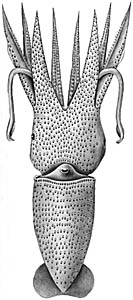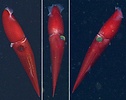Histioteuthis heteropsis
Richard E. Young and Michael VecchioneIntroduction
H. heteropsis is similar to its closest relative, H. meleagroteuthis, in the uniform, dense pattern of complex photophores on the head, arms IV and the mantle but lacks tubercules. This species is common off the coast of Southern California (USA) and has been observed from submersibles many times. It is lethargic in response to disturbance by an ROV; movements are slow and deliberate, even when jetting, inking is rarely observed (Hunt, 1966). The geographical distribution is unusual in that two separate populations exist one in the North Pacific and one in the South Pacific (antitropical distribution). It is found in temperate regions on the eastern side of the Pacific. Off southern California it occupies mesopelagic depths during the day and migrates vertically at night, presumably to feed. Maximum recorded size is 132 mm ML (Voss, et al., 1998).
Brief diagnosis:
A Histioteuthis ...
- with photophores in 8-10 series on arm IV base.
- without tubercules.
Characteristics
- Head
- Beaks: Descriptions can be found here: Lower beak; upper beak.
- Left eye much larger than right eye as in all histioteuthids.
- Tubercles
- Absent
Comments
More details of the description can be found here.Species of the meleagroteuthis-group are distinguished by the following characteristics:
- Photophores
- In 8-10 series on arm IV base.
- Usually 19-22 photophores on right eyelid.
- Compound photophores of uniform size, small and densely packed on anterior 3/4 of ventral mantle.


Figure. Ventrolateral view of the head and ventral arms of H. heteropsis showing arrangement of photophores. Photograph by Henk-Jan Hoving.
H. heteropsis is easily separated from its closest relative, H. meleagroteuthis, by the absence of tubercles.
The above information is taken from Voss (1969) and Voss, et al. (1998).
Nomenclature
The holotype (by subsequent designation) is no longer extant. The single paratype, a female, exists at the California Academy of Sciences, San Francisco (Sweeney et al., 1988).
Life History
Males mature between 54-89 mm ML; size of maturity of females is unknown (Voss et al., 1998). Paralarvae (i.e., pre-photophore stage) have not been described.
Behavior
Little is know about how squids close their eyelids, including a rapid blink, or the differences that seem to exist among taxa. Below is an in situ photographic record of a blink of the large left eye of H. heteropsis. Note that the closing mechanism seems to be complex and that the eyelid is completely closed.Distribution
Vertical distribution
These data from a vertical distribution study off Southern California shows that H. heteropsis migrates vertically from over 400 m during the day into the upper 400 m at night (Roper and Young, 1975.).


Figure. Chart of the vertical distribution of H. heteropsis, California waters. Captures were made with open 3-m trawls. Blue color - Night captures. Yellow color - Day captures. Lighter hues - Correction factor to adjust for unequal trawling time at each depth. Chart modified from Roper and Young (1975).
Geographical distribution
Type locality: Eastern North Pacific, off Santa Barbara Island. H. heteropsis is common in the California Current system between 24° and 45° N. It is also common in the Peru-Chile Current system between 30° and 36° S. In tropical waters it is generally replaced by its close relative, H. meleagroteuthis, although a single record (00° 38'S, 89° 29'W) is known from equatorial waters (Voss, et al., 1998).
References
Roper, C. F. E. and R. E. Young. 1975. Vertical distribution of pelagic cephalopods. Smithsonian Contributions to Zoology, 209: 1-51.
Voss, N. A. 1969. A monograph of the Cephalopoda of the North Atlantic: The family Histioteuthidae. Bull. Mar. Sci., 19: 713-867.
Voss, N.A., K. N. Nesis, P. G. Rodhouse. 1998. The cephalopod family Histioteuthidae (Oegopsida): Systematics, biology, and biogeography. Smithson. Contr. Zool., 586(2): 293-372.
Young, R. E. 1972. The systematics and areal distribution of pelagic cephalopods from the seas off Southern California. Smithson. Contr. Zool., 97: 1-159.
Title Illustrations

| Scientific Name | Histioteuthis heteropsis |
|---|---|
| Location | Eastern North Pacific off Monterey, California at 36.7°N, 122.05°W |
| Comments | In situ photograph of H.heteropsis taken at a depth of 739 m. |
| Acknowledgements | Image courtesy of the Monterey Bay Aquarium Research Institute (MBARI). You must obtain permission from MBARI to use this photo; please contact pressroom@mbari.org for further information. |
| View | Right side, dorsal side, left side |
| Size | Unknown |
| Copyright | © 2013 MBARI |
About This Page

University of Hawaii, Honolulu, HI, USA

National Museum of Natural History, Washington, D. C. , USA
Page copyright © 2016 and
 Page: Tree of Life
Histioteuthis heteropsis .
Authored by
Richard E. Young and Michael Vecchione.
The TEXT of this page is licensed under the
Creative Commons Attribution-NonCommercial License - Version 3.0. Note that images and other media
featured on this page are each governed by their own license, and they may or may not be available
for reuse. Click on an image or a media link to access the media data window, which provides the
relevant licensing information. For the general terms and conditions of ToL material reuse and
redistribution, please see the Tree of Life Copyright
Policies.
Page: Tree of Life
Histioteuthis heteropsis .
Authored by
Richard E. Young and Michael Vecchione.
The TEXT of this page is licensed under the
Creative Commons Attribution-NonCommercial License - Version 3.0. Note that images and other media
featured on this page are each governed by their own license, and they may or may not be available
for reuse. Click on an image or a media link to access the media data window, which provides the
relevant licensing information. For the general terms and conditions of ToL material reuse and
redistribution, please see the Tree of Life Copyright
Policies.
- Content changed 27 February 2016
Citing this page:
Young, Richard E. and Michael Vecchione. 2016. Histioteuthis heteropsis . Version 27 February 2016 (under construction). http://tolweb.org/Histioteuthis_heteropsis/19809/2016.02.27 in The Tree of Life Web Project, http://tolweb.org/











 Go to quick links
Go to quick search
Go to navigation for this section of the ToL site
Go to detailed links for the ToL site
Go to quick links
Go to quick search
Go to navigation for this section of the ToL site
Go to detailed links for the ToL site